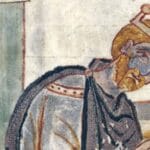Step into the intriguing world of Aethelstan, the enigmatic king who left an indelible mark on Anglo-Saxon England. Delve into the captivating details of his reign, separating historical truths from dramatic liberties taken in the popular TV series “The Last Kingdom.” Uncover the true nature of Aethelstan’s legacy and discover how this pivotal figure shaped the course of English history.
Aethelstan: The Last Kingdom’s Real-Life Inspiration
The captivating Aethelstan from “The Last Kingdom” is not just a fictional character; he’s based on a real historical figure who was even more remarkable. Aethelstan, the King of Wessex, played a pivotal role in uniting England, not through brute force, but through his intelligence and diplomacy. His reign ushered in an era of peace and prosperity known as the “Pax Athelstan.”
While the show draws inspiration from his life, it does take creative liberties. Unlike his on-screen counterpart, the real Aethelstan was a statesman who strategically expanded his kingdom through alliances and carefully planned conquests. His ability to unite England under his rule speaks volumes about his political prowess.
Aethelstan’s influence extended beyond unification. He was a reformer who implemented new laws, promoted Christianity, and ignited a cultural revival. His reign was a defining moment, setting the stage for a stable and flourishing England. “The Last Kingdom” offers a glimpse into the complexities of Anglo-Saxon England, with Aethelstan serving as both a captivating character and a symbol of England’s rich history.
Who Was Aethelstan: The Real Last Kingdom King?
While the Aethelstan portrayed in “The Last Kingdom” is a captivating figure, the real Æthelstan of Wessex (894-939 AD) was an even more remarkable individual. He earned the unique distinction of being the first ruler to call himself “King of all England” in 927 AD, a title that resonated throughout history.
A Royal Trailblazer
Born to King Edward the Elder and Ecgwynn, Aethelstan was destined for greatness. He ascended to the throne of Wessex and later became King of Mercia in 924 AD. His military prowess was undeniable, as he strategically conquered the last Viking kingdom in York in 927 AD, solidifying his legendary status as the King of all England. Despite his military achievements, he was known for his fairness, wisdom, and genuine concern for his people.
A Transformative Reign
During the Anglo-Saxon era, England was fragmented into separate, often warring, kingdoms. Aethelstan rose to the challenge, uniting these factions into a single, strong nation. He established a centralized government and implemented a unified legal system – revolutionary concepts for the time. His reign wasn’t solely focused on law and order; Aethelstan was a fervent supporter of education and Christianity, commissioning the construction of numerous churches and monasteries. He even extended his patronage to the arts, demonstrating his commitment to a flourishing culture. It’s no wonder his reign earned the moniker “Pax Athelstan,” signifying not merely a period of peace, but a golden age for England.
An Enduring Legacy
Aethelstan’s impact continues to resonate today. He laid the foundation for a unified England, establishing a legacy of unity that endures to this day. His example as a just and powerful ruler left an indelible mark on English culture, solidifying his place as one of the most significant figures in English history.
Aethelstan: A Summary
- First King of all England: A title that speaks for itself.
- Reigned from 925 to 939 AD: His reign, the “Pax Athelstan,” was marked by peace and prosperity.
- Unified England, established a central government, and championed Christianity: The hallmarks of a great and influential leader.
- Considered one of the greatest Anglo-Saxon rulers: His legacy continues to inspire.
Aethelstan’s Reign: From Conquest to Unification
Aethelstan’s ambitions extended beyond the borders of Wessex. He envisioned a unified England under his rule, and in 927 AD, he achieved this goal by conquering the last Viking kingdom in York. This decisive victory secured his title as the first true King of England.
Unifying a kingdom divided for centuries was a formidable task, but Aethelstan’s strategic brilliance shone through. He established a unified legal system and implemented new laws to ensure fairness and stability. To protect his newly unified kingdom, he ordered the construction of “burhs,” fortified towns that served as both defensive strongholds and bustling centers of trade.
Aethelstan understood that a strong kingdom needed more than military might – it required intellectual growth. He became a staunch patron of education and the arts, transforming monasteries into centers of learning and fostering a flourishing artistic scene. His reign saw the creation of exquisite manuscripts and a resurgence of intellectual pursuit, all thanks to his vision.
Aethelstan’s impact on England was profound. By uniting its people, establishing just laws, and fostering education and culture, he shaped the nation’s destiny. He is remembered as Aethelstan the Great, the unifier, the builder, and the scholar king who laid the foundation for the England we know today.
Aethelstan in The Last Kingdom: Fact vs. Fiction
“The Last Kingdom” has captivated audiences with its gripping portrayal of historical figures, and Aethelstan, played by Harry Gilby, is no exception. While the show draws inspiration from historical events, it does employ creative license. Let’s delve into the historical accuracy of Aethelstan’s portrayal.
Historically, Aethelstan was the son of King Edward the Elder, though their relationship was complex due to Aethelstan’s illegitimate birth. Upon Edward’s death in 925, Aethelstan ascended to the throne of Wessex. His ambitions soon extended beyond Wessex, leading him to conquer the Viking-held York in 927 AD, earning him the title “King of the Anglo-Saxons.”
Aethelstan’s most significant achievement was uniting the often-warring Anglo-Saxon kingdoms, laying the groundwork for a unified England. “The Last Kingdom” accurately portrays the magnitude of this accomplishment. His reign, known as the “Pax Athelstan,” was characterized by relative peace and remarkable prosperity. He instituted new laws, reformed the government, and championed art and learning, solidifying his legacy as a wise and effective ruler. He also bolstered England’s defenses, establishing the kingdom as a force to be reckoned with.
While “The Last Kingdom” takes creative liberties with certain historical events and characters, its portrayal of Aethelstan captures the essence of his ambition, diplomatic skills, and complex relationships. The show offers a glimpse into the world of one of England’s most influential monarchs, even if it deviates from certain historical details.
Separating Fact from Fiction:
- Aethelstan was a real Anglo-Saxon king who reigned from 925 to 939 AD. His legacy as the unifier of England is undeniable.
- “The Last Kingdom” draws inspiration from Aethelstan’s life, highlighting his ambition, political acumen, and the challenges he faced.
- The show incorporates fictional elements to enhance the drama, but it effectively conveys the significance of Aethelstan’s reign.
Don’t forget to delve deeper into the life and reign of Aethelstan’s predecessor, King Athelstan, and his significant contributions to English history.

















Comments are closed.